Developing Health Advocacy Campaign
VerifiedAdded on 2021/05/30
|15
|3579
|19
AI Summary
Contribute Materials
Your contribution can guide someone’s learning journey. Share your
documents today.
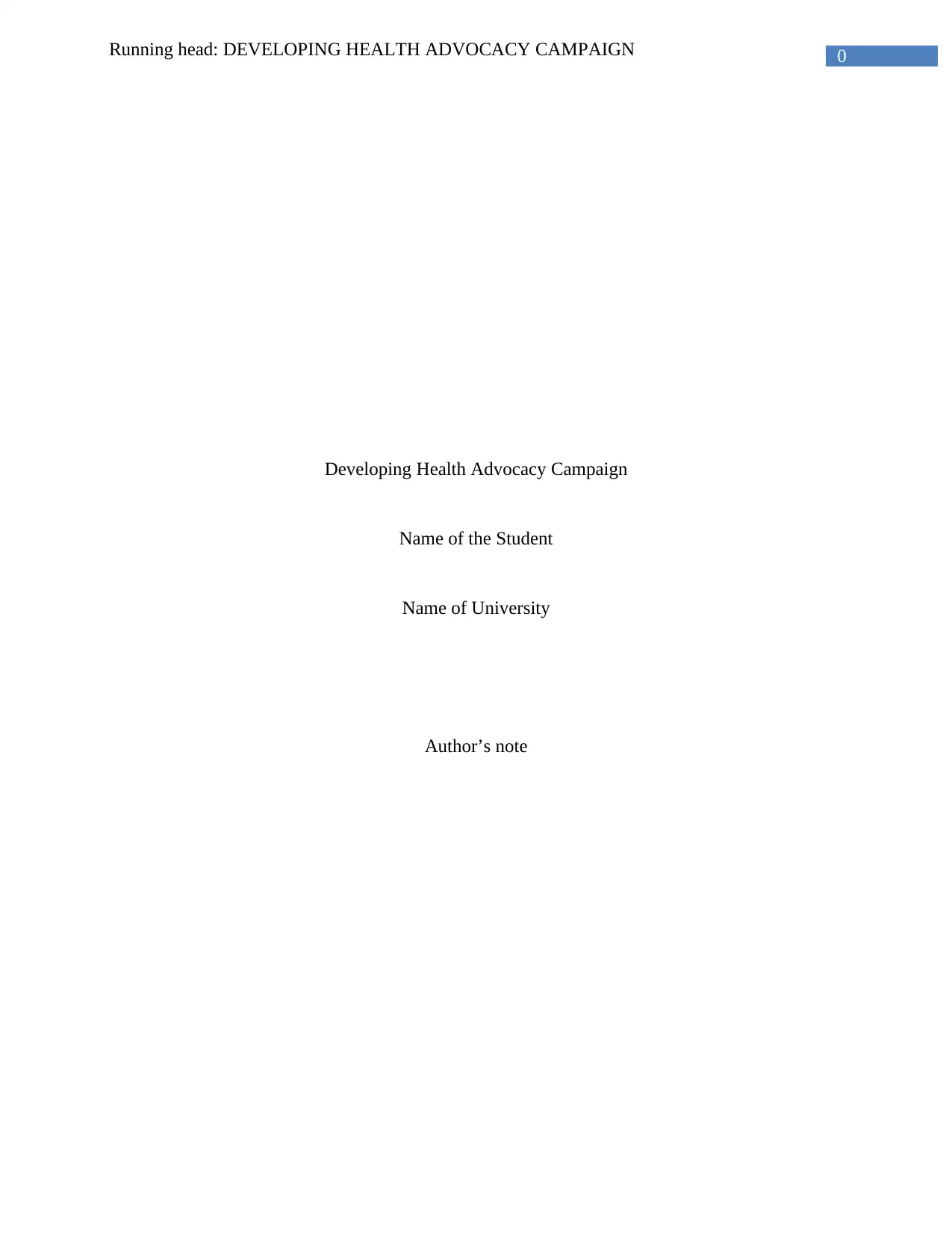
0Running head: DEVELOPING HEALTH ADVOCACY CAMPAIGN
Developing Health Advocacy Campaign
Name of the Student
Name of University
Author’s note
Developing Health Advocacy Campaign
Name of the Student
Name of University
Author’s note
Secure Best Marks with AI Grader
Need help grading? Try our AI Grader for instant feedback on your assignments.
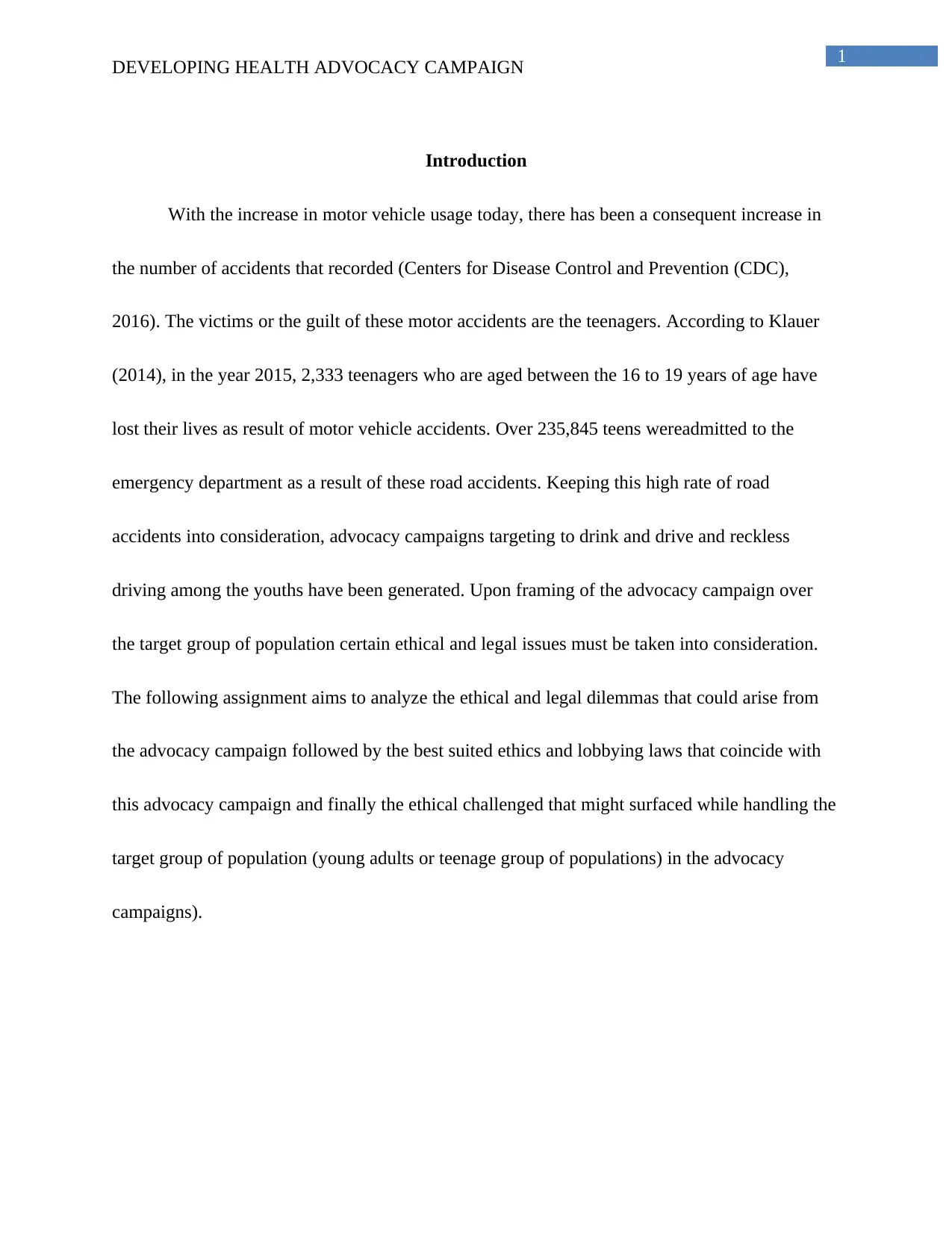
1
DEVELOPING HEALTH ADVOCACY CAMPAIGN
Introduction
With the increase in motor vehicle usage today, there has been a consequent increase in
the number of accidents that recorded (Centers for Disease Control and Prevention (CDC),
2016). The victims or the guilt of these motor accidents are the teenagers. According to Klauer
(2014), in the year 2015, 2,333 teenagers who are aged between the 16 to 19 years of age have
lost their lives as result of motor vehicle accidents. Over 235,845 teens wereadmitted to the
emergency department as a result of these road accidents. Keeping this high rate of road
accidents into consideration, advocacy campaigns targeting to drink and drive and reckless
driving among the youths have been generated. Upon framing of the advocacy campaign over
the target group of population certain ethical and legal issues must be taken into consideration.
The following assignment aims to analyze the ethical and legal dilemmas that could arise from
the advocacy campaign followed by the best suited ethics and lobbying laws that coincide with
this advocacy campaign and finally the ethical challenged that might surfaced while handling the
target group of population (young adults or teenage group of populations) in the advocacy
campaigns).
DEVELOPING HEALTH ADVOCACY CAMPAIGN
Introduction
With the increase in motor vehicle usage today, there has been a consequent increase in
the number of accidents that recorded (Centers for Disease Control and Prevention (CDC),
2016). The victims or the guilt of these motor accidents are the teenagers. According to Klauer
(2014), in the year 2015, 2,333 teenagers who are aged between the 16 to 19 years of age have
lost their lives as result of motor vehicle accidents. Over 235,845 teens wereadmitted to the
emergency department as a result of these road accidents. Keeping this high rate of road
accidents into consideration, advocacy campaigns targeting to drink and drive and reckless
driving among the youths have been generated. Upon framing of the advocacy campaign over
the target group of population certain ethical and legal issues must be taken into consideration.
The following assignment aims to analyze the ethical and legal dilemmas that could arise from
the advocacy campaign followed by the best suited ethics and lobbying laws that coincide with
this advocacy campaign and finally the ethical challenged that might surfaced while handling the
target group of population (young adults or teenage group of populations) in the advocacy
campaigns).

2
DEVELOPING HEALTH ADVOCACY CAMPAIGN
Ethical dilemmas and how to resolve
Criminalization
In the intersection of moral philosophy and law the main question which arises is what
acts should be regarded as criminal offence and what acts will demand punishment. For obvious
reasons, there are numerous drunk and drive accidents among the youths that are criminalized
and there is a constant discussion in various spheres of society regarding which kind of acts
should be penalized and how. There are two important philosophical perspectives that can be on
punishment. The perspective is retributivists approach that argue that punishment are given
because the offenders deserve to be punished. On the other hand, consequentialists are of the
opinion that punishment is only justified if it has more advantageous consequences in
comparison to refraining punishing will. Drunk driving is regarded to be immoral and the road
accidents occurring due to intoxicated drives which results in fatality often generate emotionally
laden argument centering how to punish these drunk drivers. Here two philosophical views over
punishment becomes clear when few people consider long prison sentences and tally drunk
driving to murder, where as other express their confusion as to whether this is effective that is
highlighting on the consequences(Fahlquist,2009). In order to prevent drunk and drive, Hansen
(2015) has proposed a method of alcohol interlock. It is a technical tool that makes it impossible
for the drive to drive after consuming certain percentage of alcohol. Here the drivers have to
prove their sobriety via exhalation sample before starting the car’s engine. The interlock here is
DEVELOPING HEALTH ADVOCACY CAMPAIGN
Ethical dilemmas and how to resolve
Criminalization
In the intersection of moral philosophy and law the main question which arises is what
acts should be regarded as criminal offence and what acts will demand punishment. For obvious
reasons, there are numerous drunk and drive accidents among the youths that are criminalized
and there is a constant discussion in various spheres of society regarding which kind of acts
should be penalized and how. There are two important philosophical perspectives that can be on
punishment. The perspective is retributivists approach that argue that punishment are given
because the offenders deserve to be punished. On the other hand, consequentialists are of the
opinion that punishment is only justified if it has more advantageous consequences in
comparison to refraining punishing will. Drunk driving is regarded to be immoral and the road
accidents occurring due to intoxicated drives which results in fatality often generate emotionally
laden argument centering how to punish these drunk drivers. Here two philosophical views over
punishment becomes clear when few people consider long prison sentences and tally drunk
driving to murder, where as other express their confusion as to whether this is effective that is
highlighting on the consequences(Fahlquist,2009). In order to prevent drunk and drive, Hansen
(2015) has proposed a method of alcohol interlock. It is a technical tool that makes it impossible
for the drive to drive after consuming certain percentage of alcohol. Here the drivers have to
prove their sobriety via exhalation sample before starting the car’s engine. The interlock here is
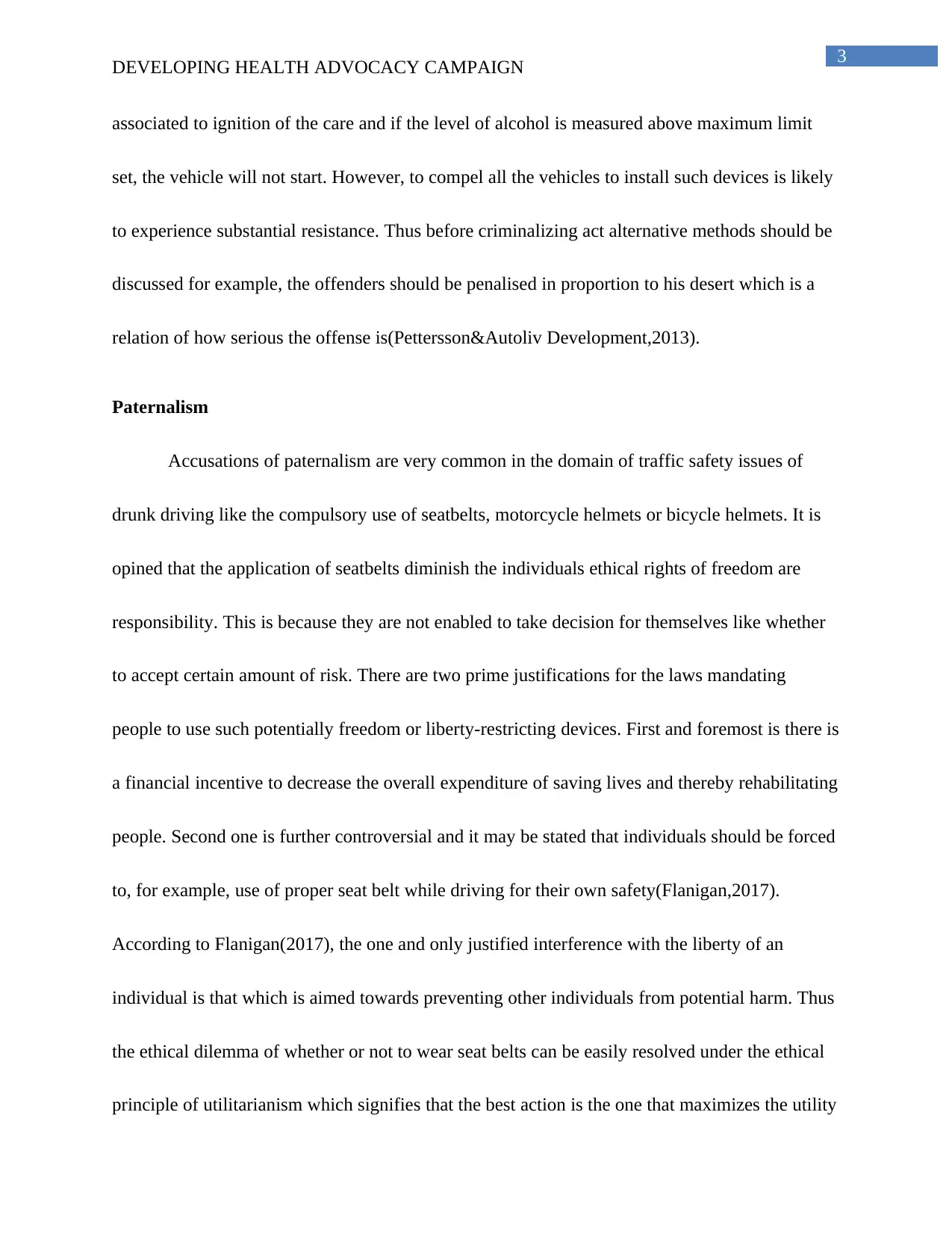
3
DEVELOPING HEALTH ADVOCACY CAMPAIGN
associated to ignition of the care and if the level of alcohol is measured above maximum limit
set, the vehicle will not start. However, to compel all the vehicles to install such devices is likely
to experience substantial resistance. Thus before criminalizing act alternative methods should be
discussed for example, the offenders should be penalised in proportion to his desert which is a
relation of how serious the offense is(Pettersson&Autoliv Development,2013).
Paternalism
Accusations of paternalism are very common in the domain of traffic safety issues of
drunk driving like the compulsory use of seatbelts, motorcycle helmets or bicycle helmets. It is
opined that the application of seatbelts diminish the individuals ethical rights of freedom are
responsibility. This is because they are not enabled to take decision for themselves like whether
to accept certain amount of risk. There are two prime justifications for the laws mandating
people to use such potentially freedom or liberty-restricting devices. First and foremost is there is
a financial incentive to decrease the overall expenditure of saving lives and thereby rehabilitating
people. Second one is further controversial and it may be stated that individuals should be forced
to, for example, use of proper seat belt while driving for their own safety(Flanigan,2017).
According to Flanigan(2017), the one and only justified interference with the liberty of an
individual is that which is aimed towards preventing other individuals from potential harm. Thus
the ethical dilemma of whether or not to wear seat belts can be easily resolved under the ethical
principle of utilitarianism which signifies that the best action is the one that maximizes the utility
DEVELOPING HEALTH ADVOCACY CAMPAIGN
associated to ignition of the care and if the level of alcohol is measured above maximum limit
set, the vehicle will not start. However, to compel all the vehicles to install such devices is likely
to experience substantial resistance. Thus before criminalizing act alternative methods should be
discussed for example, the offenders should be penalised in proportion to his desert which is a
relation of how serious the offense is(Pettersson&Autoliv Development,2013).
Paternalism
Accusations of paternalism are very common in the domain of traffic safety issues of
drunk driving like the compulsory use of seatbelts, motorcycle helmets or bicycle helmets. It is
opined that the application of seatbelts diminish the individuals ethical rights of freedom are
responsibility. This is because they are not enabled to take decision for themselves like whether
to accept certain amount of risk. There are two prime justifications for the laws mandating
people to use such potentially freedom or liberty-restricting devices. First and foremost is there is
a financial incentive to decrease the overall expenditure of saving lives and thereby rehabilitating
people. Second one is further controversial and it may be stated that individuals should be forced
to, for example, use of proper seat belt while driving for their own safety(Flanigan,2017).
According to Flanigan(2017), the one and only justified interference with the liberty of an
individual is that which is aimed towards preventing other individuals from potential harm. Thus
the ethical dilemma of whether or not to wear seat belts can be easily resolved under the ethical
principle of utilitarianism which signifies that the best action is the one that maximizes the utility
Secure Best Marks with AI Grader
Need help grading? Try our AI Grader for instant feedback on your assignments.
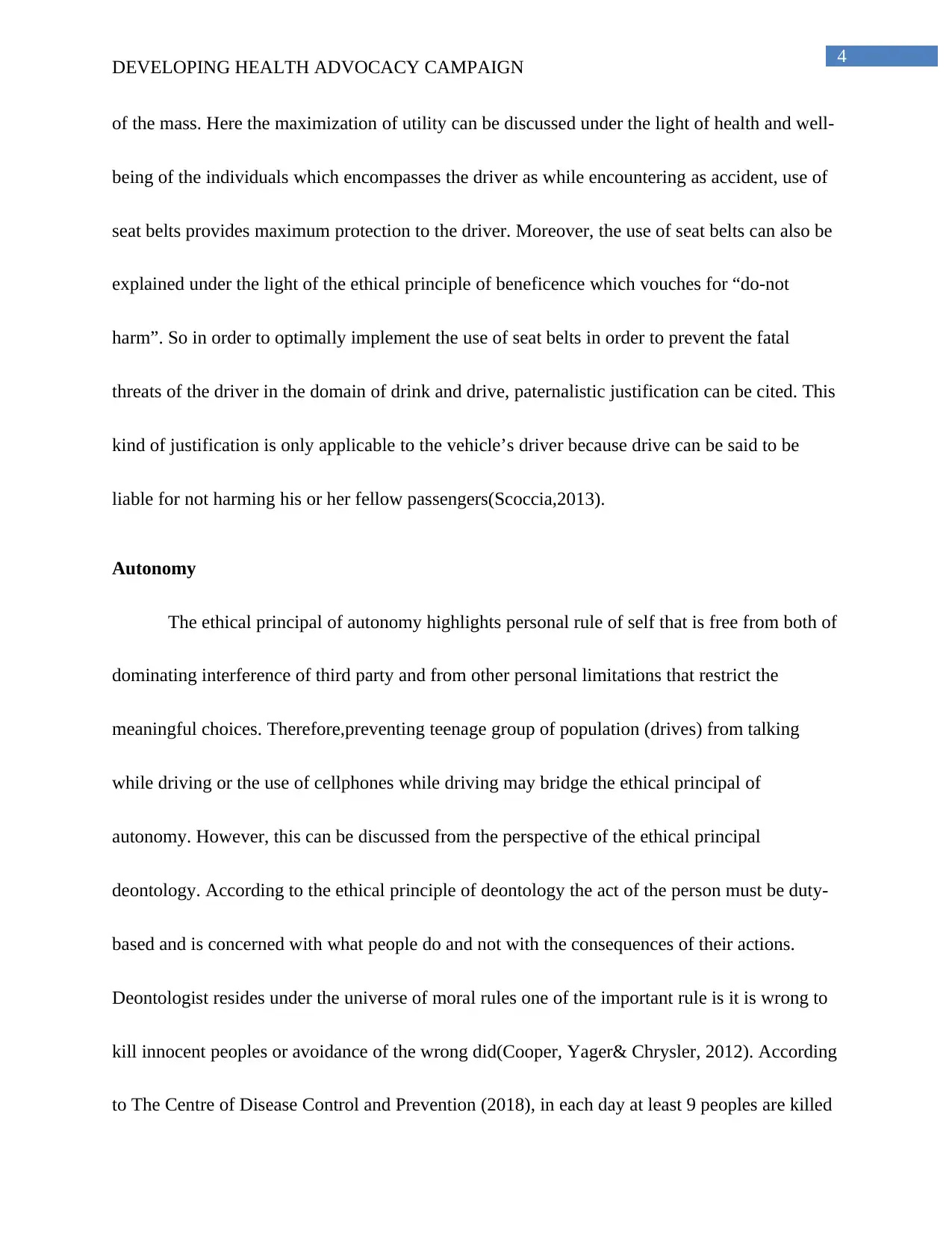
4
DEVELOPING HEALTH ADVOCACY CAMPAIGN
of the mass. Here the maximization of utility can be discussed under the light of health and well-
being of the individuals which encompasses the driver as while encountering as accident, use of
seat belts provides maximum protection to the driver. Moreover, the use of seat belts can also be
explained under the light of the ethical principle of beneficence which vouches for “do-not
harm”. So in order to optimally implement the use of seat belts in order to prevent the fatal
threats of the driver in the domain of drink and drive, paternalistic justification can be cited. This
kind of justification is only applicable to the vehicle’s driver because drive can be said to be
liable for not harming his or her fellow passengers(Scoccia,2013).
Autonomy
The ethical principal of autonomy highlights personal rule of self that is free from both of
dominating interference of third party and from other personal limitations that restrict the
meaningful choices. Therefore,preventing teenage group of population (drives) from talking
while driving or the use of cellphones while driving may bridge the ethical principal of
autonomy. However, this can be discussed from the perspective of the ethical principal
deontology. According to the ethical principle of deontology the act of the person must be duty-
based and is concerned with what people do and not with the consequences of their actions.
Deontologist resides under the universe of moral rules one of the important rule is it is wrong to
kill innocent peoples or avoidance of the wrong did(Cooper, Yager& Chrysler, 2012). According
to The Centre of Disease Control and Prevention (2018), in each day at least 9 peoples are killed
DEVELOPING HEALTH ADVOCACY CAMPAIGN
of the mass. Here the maximization of utility can be discussed under the light of health and well-
being of the individuals which encompasses the driver as while encountering as accident, use of
seat belts provides maximum protection to the driver. Moreover, the use of seat belts can also be
explained under the light of the ethical principle of beneficence which vouches for “do-not
harm”. So in order to optimally implement the use of seat belts in order to prevent the fatal
threats of the driver in the domain of drink and drive, paternalistic justification can be cited. This
kind of justification is only applicable to the vehicle’s driver because drive can be said to be
liable for not harming his or her fellow passengers(Scoccia,2013).
Autonomy
The ethical principal of autonomy highlights personal rule of self that is free from both of
dominating interference of third party and from other personal limitations that restrict the
meaningful choices. Therefore,preventing teenage group of population (drives) from talking
while driving or the use of cellphones while driving may bridge the ethical principal of
autonomy. However, this can be discussed from the perspective of the ethical principal
deontology. According to the ethical principle of deontology the act of the person must be duty-
based and is concerned with what people do and not with the consequences of their actions.
Deontologist resides under the universe of moral rules one of the important rule is it is wrong to
kill innocent peoples or avoidance of the wrong did(Cooper, Yager& Chrysler, 2012). According
to The Centre of Disease Control and Prevention (2018), in each day at least 9 peoples are killed
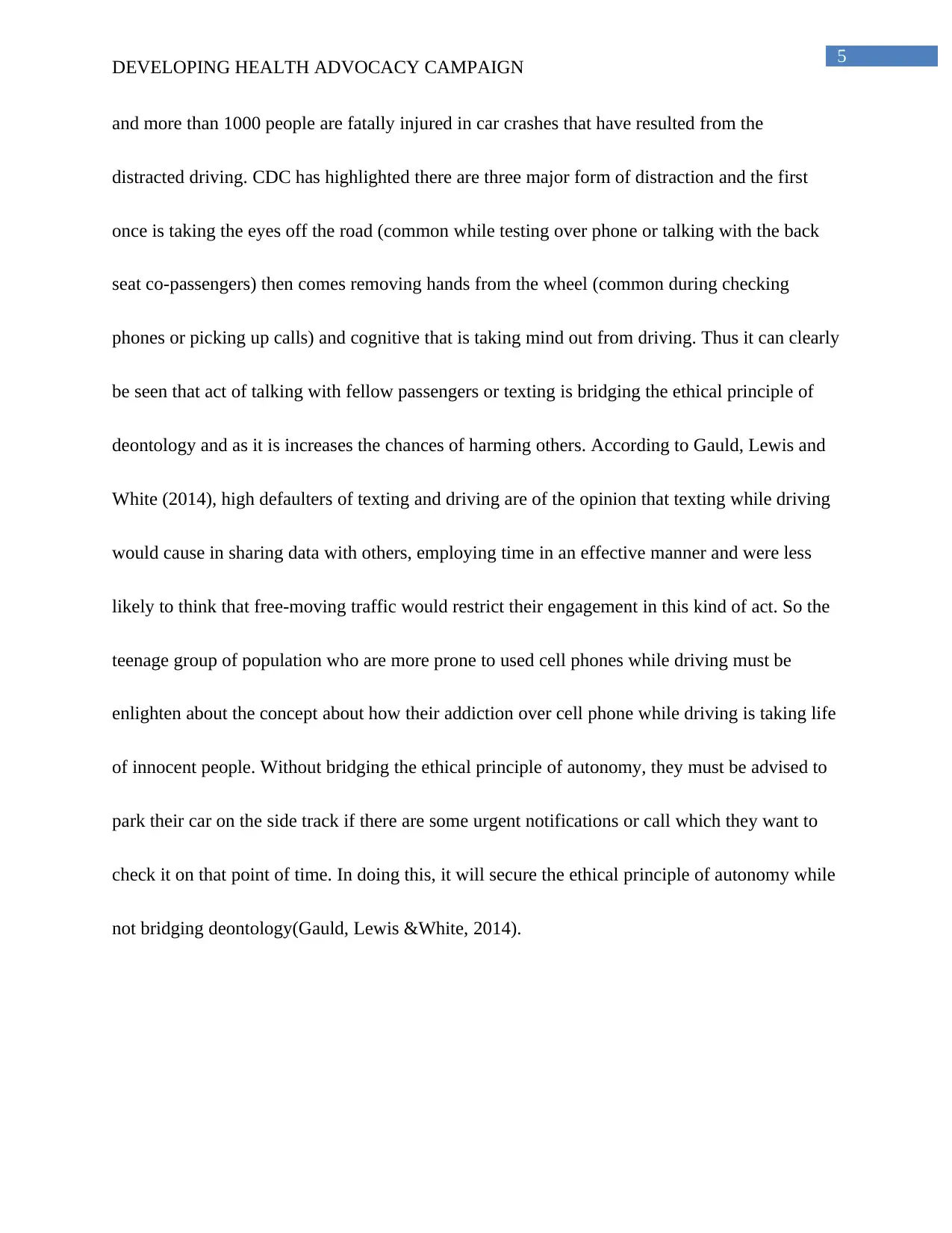
5
DEVELOPING HEALTH ADVOCACY CAMPAIGN
and more than 1000 people are fatally injured in car crashes that have resulted from the
distracted driving. CDC has highlighted there are three major form of distraction and the first
once is taking the eyes off the road (common while testing over phone or talking with the back
seat co-passengers) then comes removing hands from the wheel (common during checking
phones or picking up calls) and cognitive that is taking mind out from driving. Thus it can clearly
be seen that act of talking with fellow passengers or texting is bridging the ethical principle of
deontology and as it is increases the chances of harming others. According to Gauld, Lewis and
White (2014), high defaulters of texting and driving are of the opinion that texting while driving
would cause in sharing data with others, employing time in an effective manner and were less
likely to think that free-moving traffic would restrict their engagement in this kind of act. So the
teenage group of population who are more prone to used cell phones while driving must be
enlighten about the concept about how their addiction over cell phone while driving is taking life
of innocent people. Without bridging the ethical principle of autonomy, they must be advised to
park their car on the side track if there are some urgent notifications or call which they want to
check it on that point of time. In doing this, it will secure the ethical principle of autonomy while
not bridging deontology(Gauld, Lewis &White, 2014).
DEVELOPING HEALTH ADVOCACY CAMPAIGN
and more than 1000 people are fatally injured in car crashes that have resulted from the
distracted driving. CDC has highlighted there are three major form of distraction and the first
once is taking the eyes off the road (common while testing over phone or talking with the back
seat co-passengers) then comes removing hands from the wheel (common during checking
phones or picking up calls) and cognitive that is taking mind out from driving. Thus it can clearly
be seen that act of talking with fellow passengers or texting is bridging the ethical principle of
deontology and as it is increases the chances of harming others. According to Gauld, Lewis and
White (2014), high defaulters of texting and driving are of the opinion that texting while driving
would cause in sharing data with others, employing time in an effective manner and were less
likely to think that free-moving traffic would restrict their engagement in this kind of act. So the
teenage group of population who are more prone to used cell phones while driving must be
enlighten about the concept about how their addiction over cell phone while driving is taking life
of innocent people. Without bridging the ethical principle of autonomy, they must be advised to
park their car on the side track if there are some urgent notifications or call which they want to
check it on that point of time. In doing this, it will secure the ethical principle of autonomy while
not bridging deontology(Gauld, Lewis &White, 2014).
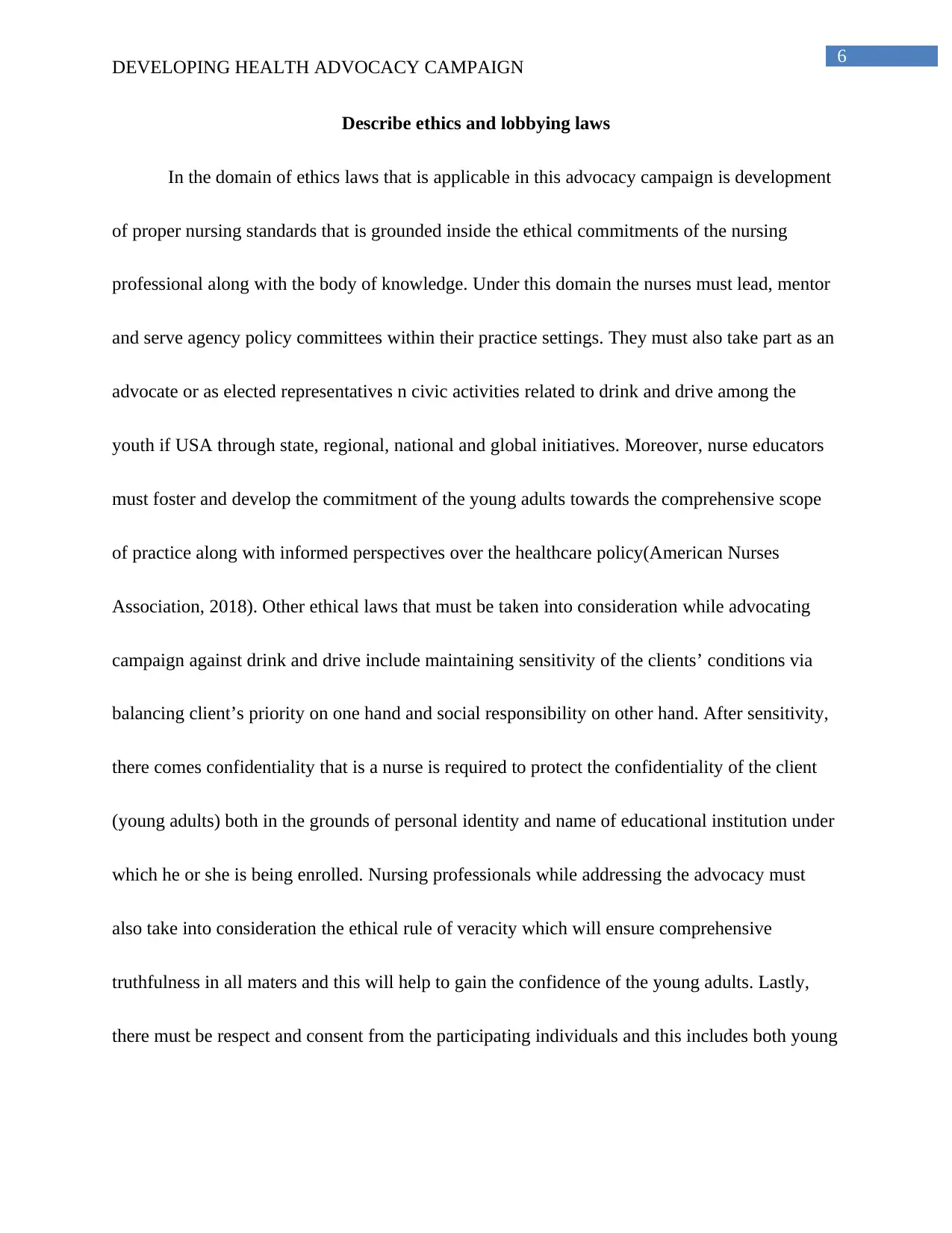
6
DEVELOPING HEALTH ADVOCACY CAMPAIGN
Describe ethics and lobbying laws
In the domain of ethics laws that is applicable in this advocacy campaign is development
of proper nursing standards that is grounded inside the ethical commitments of the nursing
professional along with the body of knowledge. Under this domain the nurses must lead, mentor
and serve agency policy committees within their practice settings. They must also take part as an
advocate or as elected representatives n civic activities related to drink and drive among the
youth if USA through state, regional, national and global initiatives. Moreover, nurse educators
must foster and develop the commitment of the young adults towards the comprehensive scope
of practice along with informed perspectives over the healthcare policy(American Nurses
Association, 2018). Other ethical laws that must be taken into consideration while advocating
campaign against drink and drive include maintaining sensitivity of the clients’ conditions via
balancing client’s priority on one hand and social responsibility on other hand. After sensitivity,
there comes confidentiality that is a nurse is required to protect the confidentiality of the client
(young adults) both in the grounds of personal identity and name of educational institution under
which he or she is being enrolled. Nursing professionals while addressing the advocacy must
also take into consideration the ethical rule of veracity which will ensure comprehensive
truthfulness in all maters and this will help to gain the confidence of the young adults. Lastly,
there must be respect and consent from the participating individuals and this includes both young
DEVELOPING HEALTH ADVOCACY CAMPAIGN
Describe ethics and lobbying laws
In the domain of ethics laws that is applicable in this advocacy campaign is development
of proper nursing standards that is grounded inside the ethical commitments of the nursing
professional along with the body of knowledge. Under this domain the nurses must lead, mentor
and serve agency policy committees within their practice settings. They must also take part as an
advocate or as elected representatives n civic activities related to drink and drive among the
youth if USA through state, regional, national and global initiatives. Moreover, nurse educators
must foster and develop the commitment of the young adults towards the comprehensive scope
of practice along with informed perspectives over the healthcare policy(American Nurses
Association, 2018). Other ethical laws that must be taken into consideration while advocating
campaign against drink and drive include maintaining sensitivity of the clients’ conditions via
balancing client’s priority on one hand and social responsibility on other hand. After sensitivity,
there comes confidentiality that is a nurse is required to protect the confidentiality of the client
(young adults) both in the grounds of personal identity and name of educational institution under
which he or she is being enrolled. Nursing professionals while addressing the advocacy must
also take into consideration the ethical rule of veracity which will ensure comprehensive
truthfulness in all maters and this will help to gain the confidence of the young adults. Lastly,
there must be respect and consent from the participating individuals and this includes both young
Paraphrase This Document
Need a fresh take? Get an instant paraphrase of this document with our AI Paraphraser
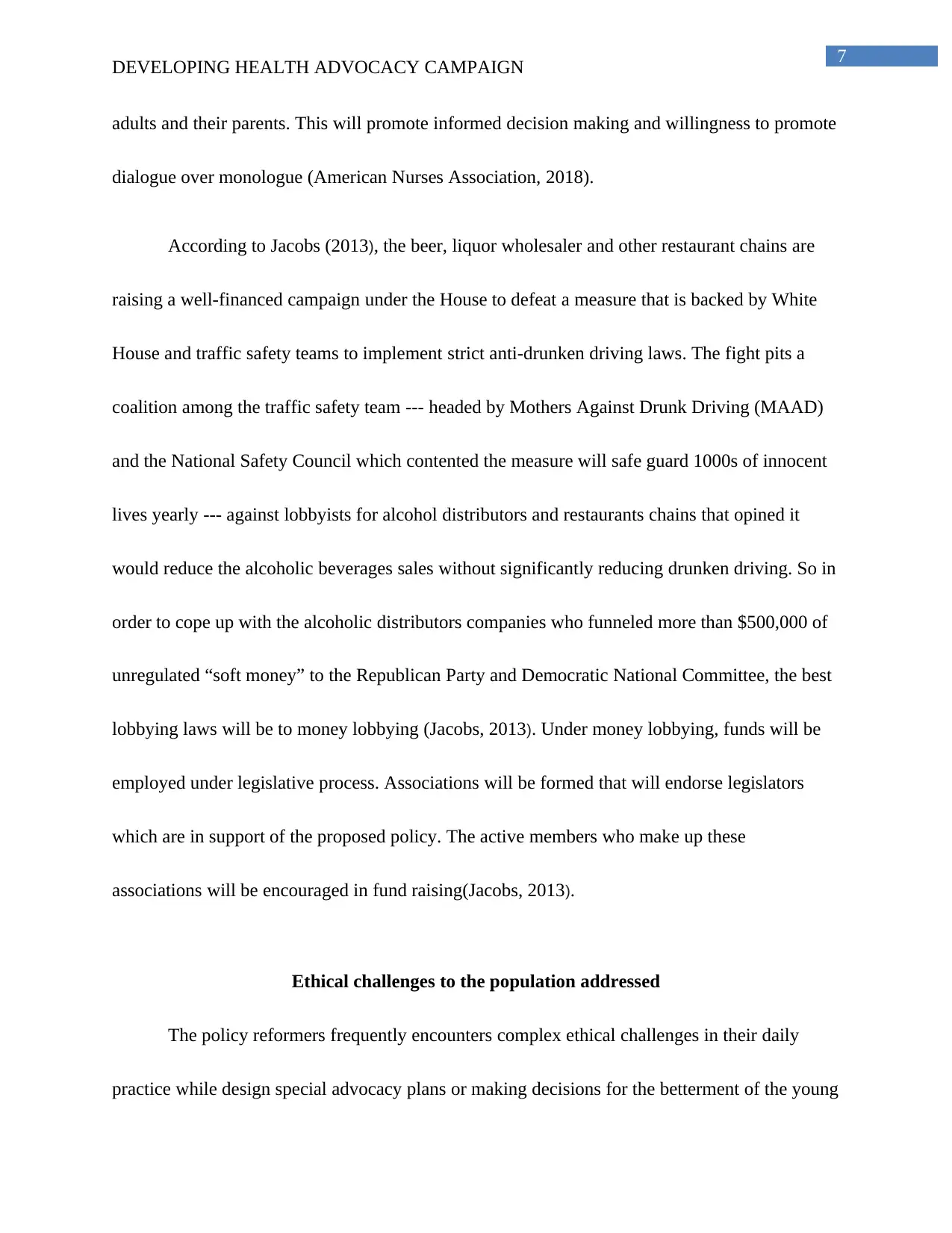
7
DEVELOPING HEALTH ADVOCACY CAMPAIGN
adults and their parents. This will promote informed decision making and willingness to promote
dialogue over monologue (American Nurses Association, 2018).
According to Jacobs (2013), the beer, liquor wholesaler and other restaurant chains are
raising a well-financed campaign under the House to defeat a measure that is backed by White
House and traffic safety teams to implement strict anti-drunken driving laws. The fight pits a
coalition among the traffic safety team --- headed by Mothers Against Drunk Driving (MAAD)
and the National Safety Council which contented the measure will safe guard 1000s of innocent
lives yearly --- against lobbyists for alcohol distributors and restaurants chains that opined it
would reduce the alcoholic beverages sales without significantly reducing drunken driving. So in
order to cope up with the alcoholic distributors companies who funneled more than $500,000 of
unregulated “soft money” to the Republican Party and Democratic National Committee, the best
lobbying laws will be to money lobbying (Jacobs, 2013). Under money lobbying, funds will be
employed under legislative process. Associations will be formed that will endorse legislators
which are in support of the proposed policy. The active members who make up these
associations will be encouraged in fund raising(Jacobs, 2013).
Ethical challenges to the population addressed
The policy reformers frequently encounters complex ethical challenges in their daily
practice while design special advocacy plans or making decisions for the betterment of the young
DEVELOPING HEALTH ADVOCACY CAMPAIGN
adults and their parents. This will promote informed decision making and willingness to promote
dialogue over monologue (American Nurses Association, 2018).
According to Jacobs (2013), the beer, liquor wholesaler and other restaurant chains are
raising a well-financed campaign under the House to defeat a measure that is backed by White
House and traffic safety teams to implement strict anti-drunken driving laws. The fight pits a
coalition among the traffic safety team --- headed by Mothers Against Drunk Driving (MAAD)
and the National Safety Council which contented the measure will safe guard 1000s of innocent
lives yearly --- against lobbyists for alcohol distributors and restaurants chains that opined it
would reduce the alcoholic beverages sales without significantly reducing drunken driving. So in
order to cope up with the alcoholic distributors companies who funneled more than $500,000 of
unregulated “soft money” to the Republican Party and Democratic National Committee, the best
lobbying laws will be to money lobbying (Jacobs, 2013). Under money lobbying, funds will be
employed under legislative process. Associations will be formed that will endorse legislators
which are in support of the proposed policy. The active members who make up these
associations will be encouraged in fund raising(Jacobs, 2013).
Ethical challenges to the population addressed
The policy reformers frequently encounters complex ethical challenges in their daily
practice while design special advocacy plans or making decisions for the betterment of the young
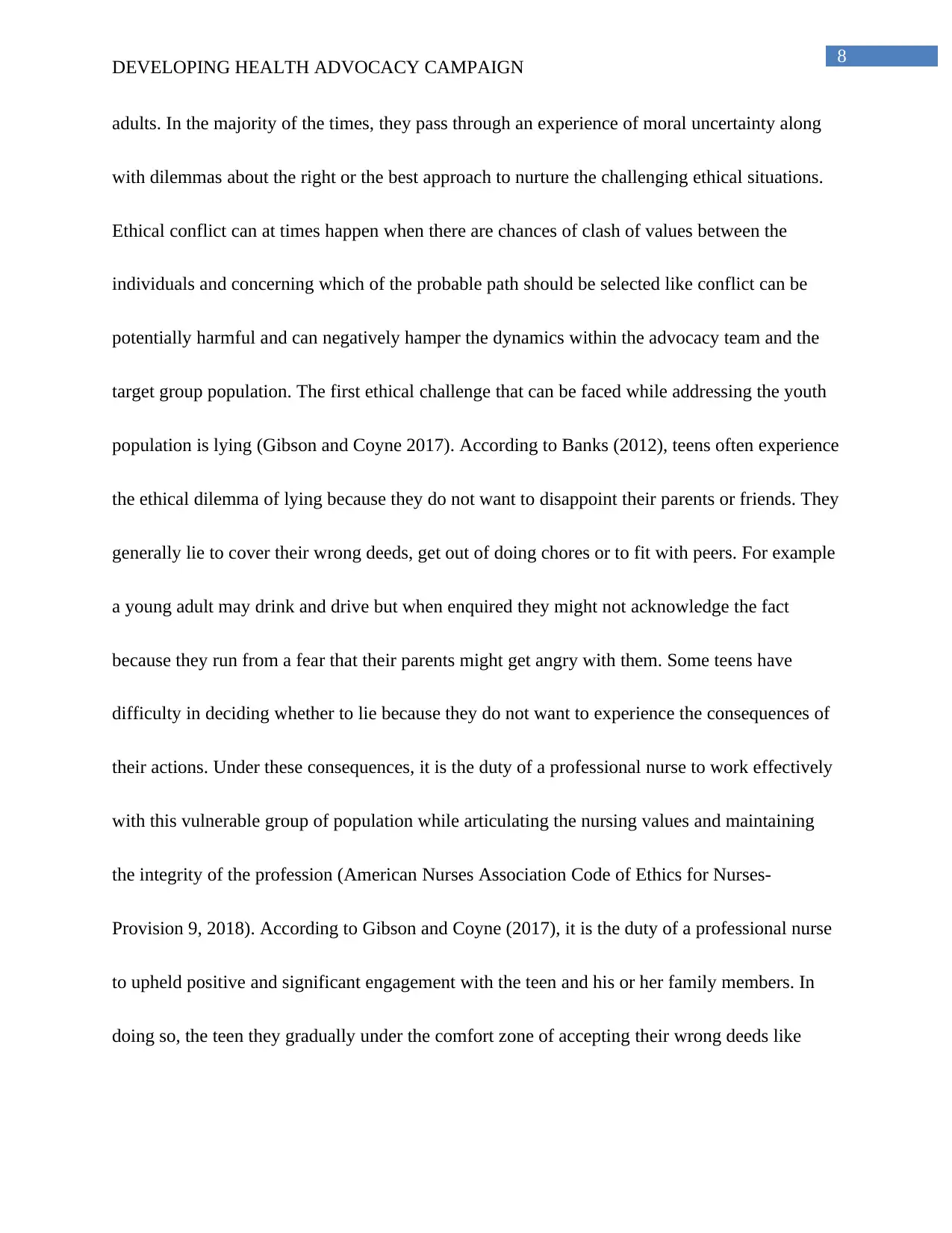
8
DEVELOPING HEALTH ADVOCACY CAMPAIGN
adults. In the majority of the times, they pass through an experience of moral uncertainty along
with dilemmas about the right or the best approach to nurture the challenging ethical situations.
Ethical conflict can at times happen when there are chances of clash of values between the
individuals and concerning which of the probable path should be selected like conflict can be
potentially harmful and can negatively hamper the dynamics within the advocacy team and the
target group population. The first ethical challenge that can be faced while addressing the youth
population is lying (Gibson and Coyne 2017). According to Banks (2012), teens often experience
the ethical dilemma of lying because they do not want to disappoint their parents or friends. They
generally lie to cover their wrong deeds, get out of doing chores or to fit with peers. For example
a young adult may drink and drive but when enquired they might not acknowledge the fact
because they run from a fear that their parents might get angry with them. Some teens have
difficulty in deciding whether to lie because they do not want to experience the consequences of
their actions. Under these consequences, it is the duty of a professional nurse to work effectively
with this vulnerable group of population while articulating the nursing values and maintaining
the integrity of the profession (American Nurses Association Code of Ethics for Nurses-
Provision 9, 2018). According to Gibson and Coyne (2017), it is the duty of a professional nurse
to upheld positive and significant engagement with the teen and his or her family members. In
doing so, the teen they gradually under the comfort zone of accepting their wrong deeds like
DEVELOPING HEALTH ADVOCACY CAMPAIGN
adults. In the majority of the times, they pass through an experience of moral uncertainty along
with dilemmas about the right or the best approach to nurture the challenging ethical situations.
Ethical conflict can at times happen when there are chances of clash of values between the
individuals and concerning which of the probable path should be selected like conflict can be
potentially harmful and can negatively hamper the dynamics within the advocacy team and the
target group population. The first ethical challenge that can be faced while addressing the youth
population is lying (Gibson and Coyne 2017). According to Banks (2012), teens often experience
the ethical dilemma of lying because they do not want to disappoint their parents or friends. They
generally lie to cover their wrong deeds, get out of doing chores or to fit with peers. For example
a young adult may drink and drive but when enquired they might not acknowledge the fact
because they run from a fear that their parents might get angry with them. Some teens have
difficulty in deciding whether to lie because they do not want to experience the consequences of
their actions. Under these consequences, it is the duty of a professional nurse to work effectively
with this vulnerable group of population while articulating the nursing values and maintaining
the integrity of the profession (American Nurses Association Code of Ethics for Nurses-
Provision 9, 2018). According to Gibson and Coyne (2017), it is the duty of a professional nurse
to upheld positive and significant engagement with the teen and his or her family members. In
doing so, the teen they gradually under the comfort zone of accepting their wrong deeds like

9
DEVELOPING HEALTH ADVOCACY CAMPAIGN
drinking and driving or texting while driving in front of their parents and thereby helping the
nursing professionals to create the counseling program accordingly.
According to Bachman et al. (2013) young adults smoke or drink not to satisfy their
desire of intoxication but to fit into certain bracket of the society. Banks(2012) have opined that
majority of the teens face ethical dilemmas of choosing whether to drink or smoke. Some teens
rationalize that it is permissible to smoke or drink as long as they do not drive while intoxicated.
While others select to partake because they want to fit themselves within a certain crowd.
However, compelling children and forbidding the young adults from smoking and drinking who
are already into addiction might make the situation worse. According to Bachman et al. (2013),
young adults when forbid from certain act beyond their will, they do not take it positively. It
hampers their sense of autonomy and human rights which is extremely vulnerable at this point of
age and might canst certain adverse impact leading to increase in the tendency to smoke of drink.
Banks(2012) is of the opinion that it is the duty of the professional nurses to act in collaboration
with the other healthcare professionals (psychiatrist in this case) to create an environment where
the young adults do not feel forced to do something or might feel that the decision is affecting
their autonomy. Thus protecting human rights and promoting health diplomacy is the best thing
that can be done in this case (American Nurses Association Code of Ethics for Nurses-Provision
8, 2018). () highlighted that this facilitating environment can be achieved via honest
communication which will help the teens to work with their complex ethical dilemmas. This
DEVELOPING HEALTH ADVOCACY CAMPAIGN
drinking and driving or texting while driving in front of their parents and thereby helping the
nursing professionals to create the counseling program accordingly.
According to Bachman et al. (2013) young adults smoke or drink not to satisfy their
desire of intoxication but to fit into certain bracket of the society. Banks(2012) have opined that
majority of the teens face ethical dilemmas of choosing whether to drink or smoke. Some teens
rationalize that it is permissible to smoke or drink as long as they do not drive while intoxicated.
While others select to partake because they want to fit themselves within a certain crowd.
However, compelling children and forbidding the young adults from smoking and drinking who
are already into addiction might make the situation worse. According to Bachman et al. (2013),
young adults when forbid from certain act beyond their will, they do not take it positively. It
hampers their sense of autonomy and human rights which is extremely vulnerable at this point of
age and might canst certain adverse impact leading to increase in the tendency to smoke of drink.
Banks(2012) is of the opinion that it is the duty of the professional nurses to act in collaboration
with the other healthcare professionals (psychiatrist in this case) to create an environment where
the young adults do not feel forced to do something or might feel that the decision is affecting
their autonomy. Thus protecting human rights and promoting health diplomacy is the best thing
that can be done in this case (American Nurses Association Code of Ethics for Nurses-Provision
8, 2018). () highlighted that this facilitating environment can be achieved via honest
communication which will help the teens to work with their complex ethical dilemmas. This
Secure Best Marks with AI Grader
Need help grading? Try our AI Grader for instant feedback on your assignments.
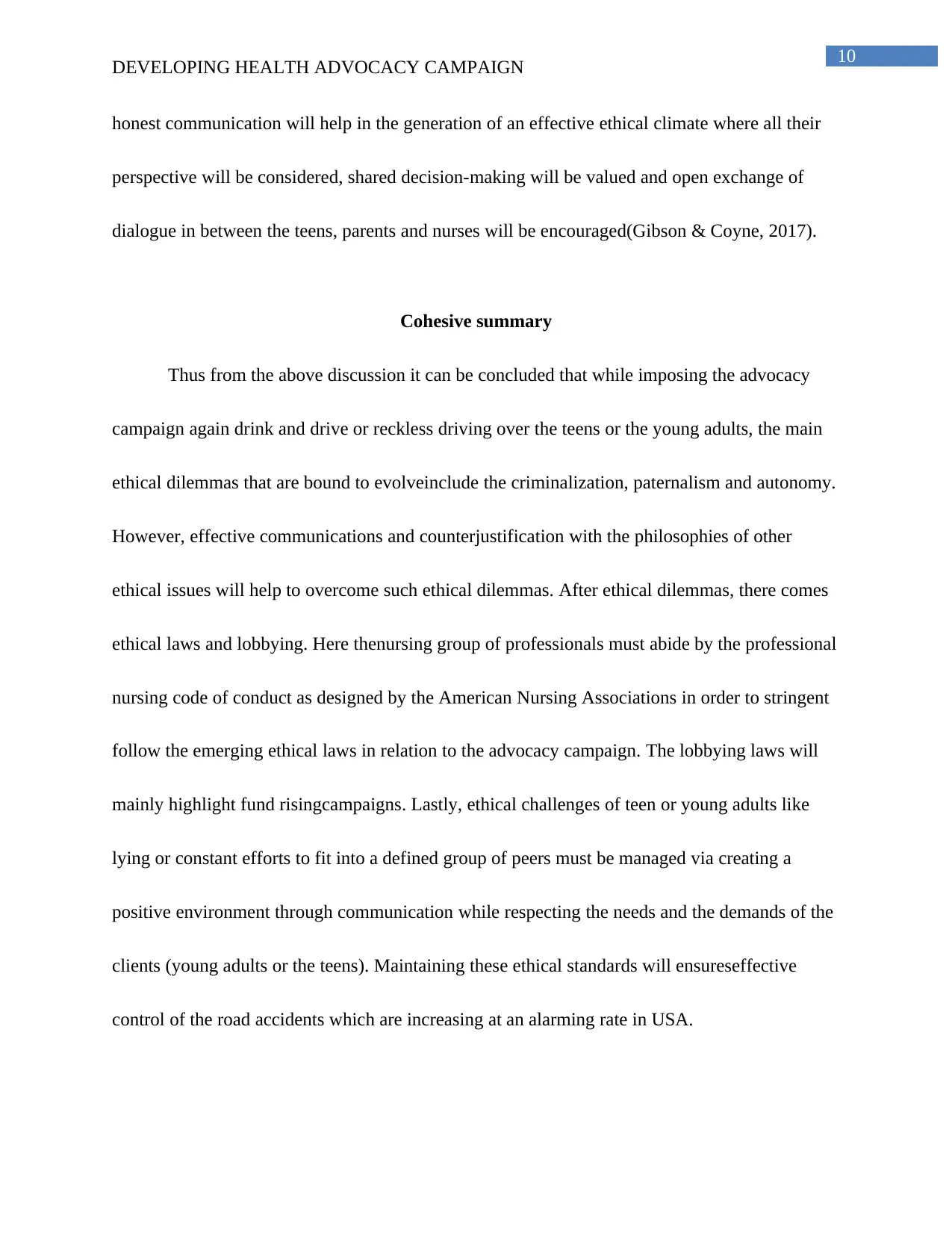
10
DEVELOPING HEALTH ADVOCACY CAMPAIGN
honest communication will help in the generation of an effective ethical climate where all their
perspective will be considered, shared decision-making will be valued and open exchange of
dialogue in between the teens, parents and nurses will be encouraged(Gibson & Coyne, 2017).
Cohesive summary
Thus from the above discussion it can be concluded that while imposing the advocacy
campaign again drink and drive or reckless driving over the teens or the young adults, the main
ethical dilemmas that are bound to evolveinclude the criminalization, paternalism and autonomy.
However, effective communications and counterjustification with the philosophies of other
ethical issues will help to overcome such ethical dilemmas. After ethical dilemmas, there comes
ethical laws and lobbying. Here thenursing group of professionals must abide by the professional
nursing code of conduct as designed by the American Nursing Associations in order to stringent
follow the emerging ethical laws in relation to the advocacy campaign. The lobbying laws will
mainly highlight fund risingcampaigns. Lastly, ethical challenges of teen or young adults like
lying or constant efforts to fit into a defined group of peers must be managed via creating a
positive environment through communication while respecting the needs and the demands of the
clients (young adults or the teens). Maintaining these ethical standards will ensureseffective
control of the road accidents which are increasing at an alarming rate in USA.
DEVELOPING HEALTH ADVOCACY CAMPAIGN
honest communication will help in the generation of an effective ethical climate where all their
perspective will be considered, shared decision-making will be valued and open exchange of
dialogue in between the teens, parents and nurses will be encouraged(Gibson & Coyne, 2017).
Cohesive summary
Thus from the above discussion it can be concluded that while imposing the advocacy
campaign again drink and drive or reckless driving over the teens or the young adults, the main
ethical dilemmas that are bound to evolveinclude the criminalization, paternalism and autonomy.
However, effective communications and counterjustification with the philosophies of other
ethical issues will help to overcome such ethical dilemmas. After ethical dilemmas, there comes
ethical laws and lobbying. Here thenursing group of professionals must abide by the professional
nursing code of conduct as designed by the American Nursing Associations in order to stringent
follow the emerging ethical laws in relation to the advocacy campaign. The lobbying laws will
mainly highlight fund risingcampaigns. Lastly, ethical challenges of teen or young adults like
lying or constant efforts to fit into a defined group of peers must be managed via creating a
positive environment through communication while respecting the needs and the demands of the
clients (young adults or the teens). Maintaining these ethical standards will ensureseffective
control of the road accidents which are increasing at an alarming rate in USA.
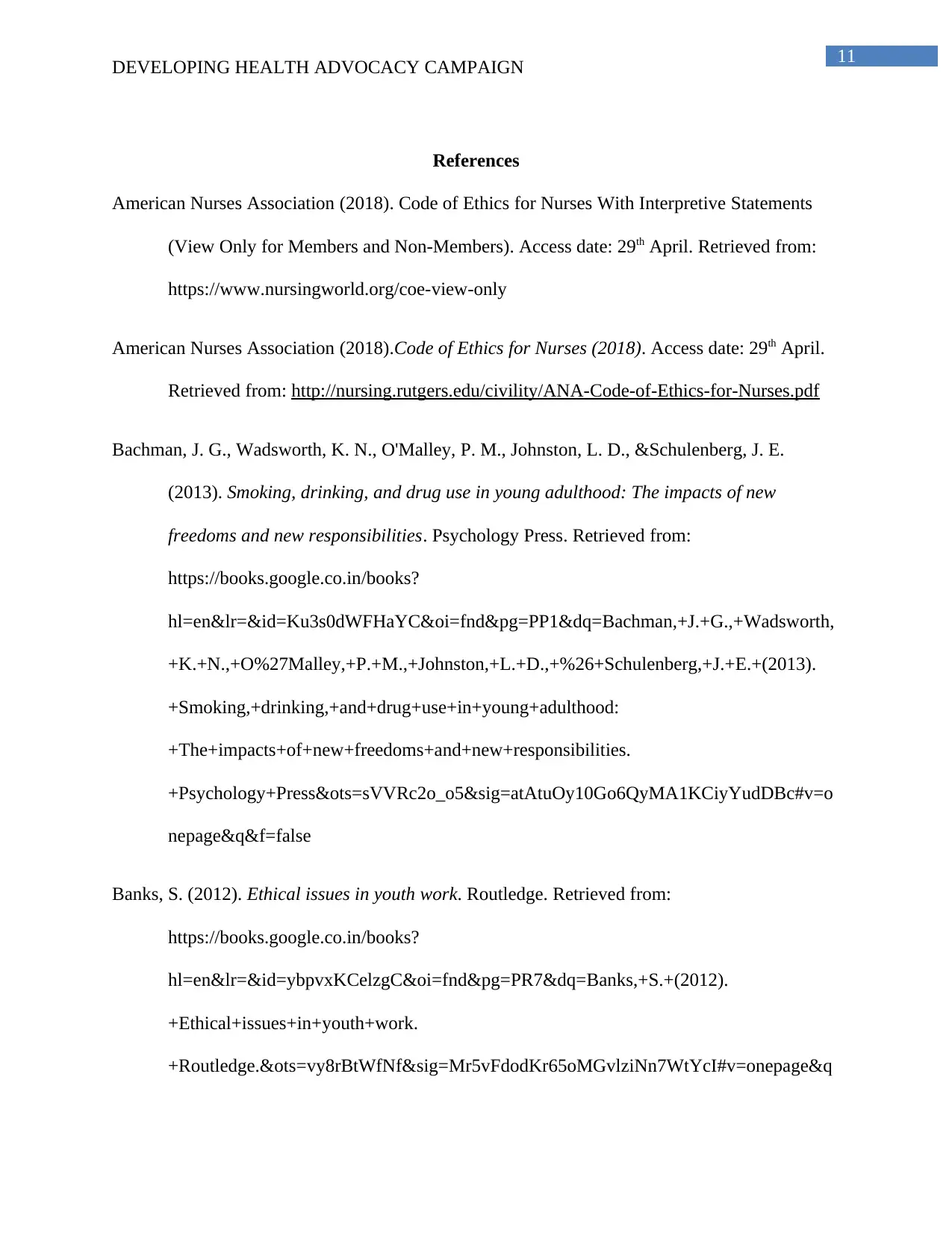
11
DEVELOPING HEALTH ADVOCACY CAMPAIGN
References
American Nurses Association (2018). Code of Ethics for Nurses With Interpretive Statements
(View Only for Members and Non-Members). Access date: 29th April. Retrieved from:
https://www.nursingworld.org/coe-view-only
American Nurses Association (2018).Code of Ethics for Nurses (2018). Access date: 29th April.
Retrieved from: http://nursing.rutgers.edu/civility/ANA-Code-of-Ethics-for-Nurses.pdf
Bachman, J. G., Wadsworth, K. N., O'Malley, P. M., Johnston, L. D., &Schulenberg, J. E.
(2013). Smoking, drinking, and drug use in young adulthood: The impacts of new
freedoms and new responsibilities. Psychology Press. Retrieved from:
https://books.google.co.in/books?
hl=en&lr=&id=Ku3s0dWFHaYC&oi=fnd&pg=PP1&dq=Bachman,+J.+G.,+Wadsworth,
+K.+N.,+O%27Malley,+P.+M.,+Johnston,+L.+D.,+%26+Schulenberg,+J.+E.+(2013).
+Smoking,+drinking,+and+drug+use+in+young+adulthood:
+The+impacts+of+new+freedoms+and+new+responsibilities.
+Psychology+Press&ots=sVVRc2o_o5&sig=atAtuOy10Go6QyMA1KCiyYudDBc#v=o
nepage&q&f=false
Banks, S. (2012). Ethical issues in youth work. Routledge. Retrieved from:
https://books.google.co.in/books?
hl=en&lr=&id=ybpvxKCelzgC&oi=fnd&pg=PR7&dq=Banks,+S.+(2012).
+Ethical+issues+in+youth+work.
+Routledge.&ots=vy8rBtWfNf&sig=Mr5vFdodKr65oMGvlziNn7WtYcI#v=onepage&q
DEVELOPING HEALTH ADVOCACY CAMPAIGN
References
American Nurses Association (2018). Code of Ethics for Nurses With Interpretive Statements
(View Only for Members and Non-Members). Access date: 29th April. Retrieved from:
https://www.nursingworld.org/coe-view-only
American Nurses Association (2018).Code of Ethics for Nurses (2018). Access date: 29th April.
Retrieved from: http://nursing.rutgers.edu/civility/ANA-Code-of-Ethics-for-Nurses.pdf
Bachman, J. G., Wadsworth, K. N., O'Malley, P. M., Johnston, L. D., &Schulenberg, J. E.
(2013). Smoking, drinking, and drug use in young adulthood: The impacts of new
freedoms and new responsibilities. Psychology Press. Retrieved from:
https://books.google.co.in/books?
hl=en&lr=&id=Ku3s0dWFHaYC&oi=fnd&pg=PP1&dq=Bachman,+J.+G.,+Wadsworth,
+K.+N.,+O%27Malley,+P.+M.,+Johnston,+L.+D.,+%26+Schulenberg,+J.+E.+(2013).
+Smoking,+drinking,+and+drug+use+in+young+adulthood:
+The+impacts+of+new+freedoms+and+new+responsibilities.
+Psychology+Press&ots=sVVRc2o_o5&sig=atAtuOy10Go6QyMA1KCiyYudDBc#v=o
nepage&q&f=false
Banks, S. (2012). Ethical issues in youth work. Routledge. Retrieved from:
https://books.google.co.in/books?
hl=en&lr=&id=ybpvxKCelzgC&oi=fnd&pg=PR7&dq=Banks,+S.+(2012).
+Ethical+issues+in+youth+work.
+Routledge.&ots=vy8rBtWfNf&sig=Mr5vFdodKr65oMGvlziNn7WtYcI#v=onepage&q
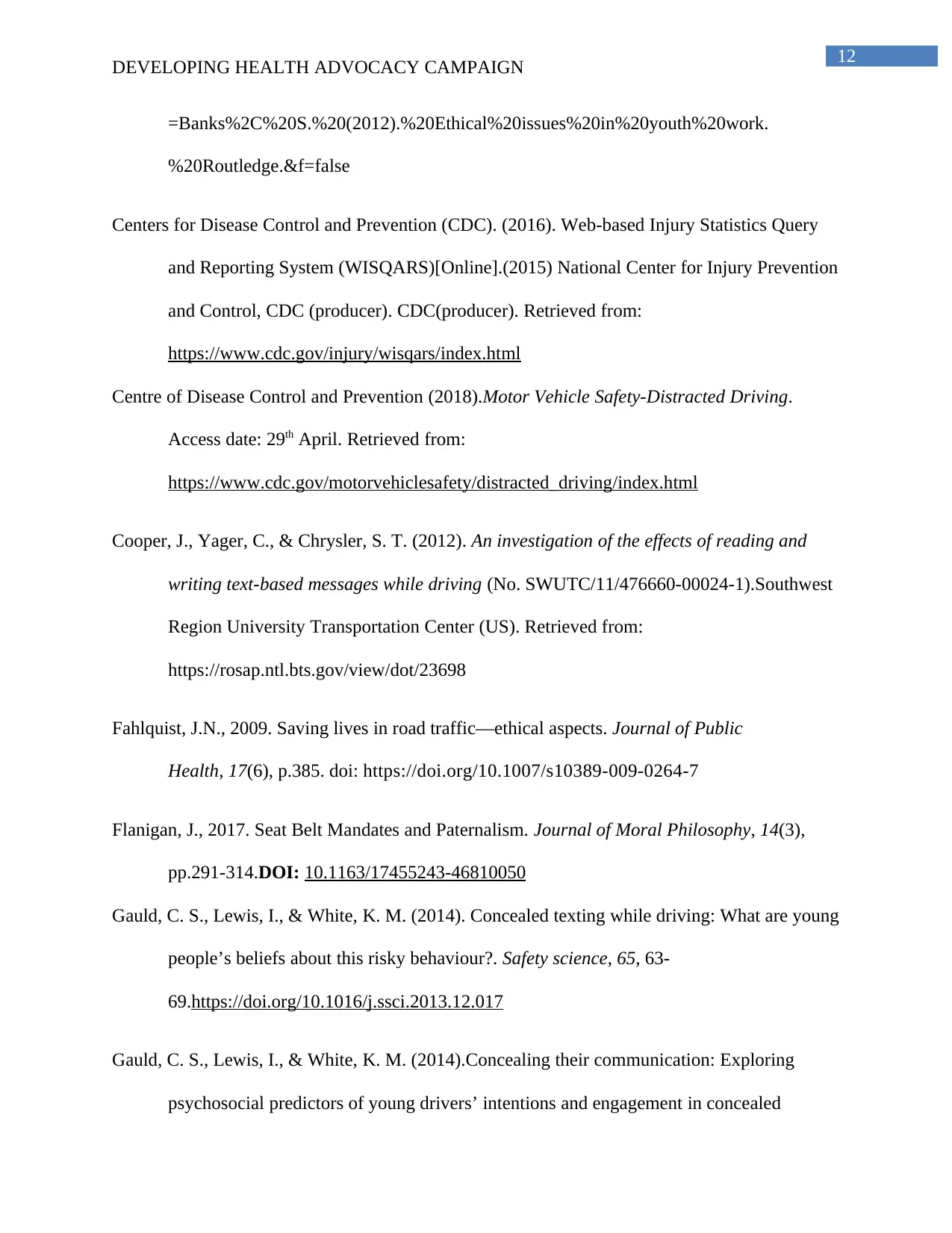
12
DEVELOPING HEALTH ADVOCACY CAMPAIGN
=Banks%2C%20S.%20(2012).%20Ethical%20issues%20in%20youth%20work.
%20Routledge.&f=false
Centers for Disease Control and Prevention (CDC). (2016). Web-based Injury Statistics Query
and Reporting System (WISQARS)[Online].(2015) National Center for Injury Prevention
and Control, CDC (producer). CDC(producer). Retrieved from:
https://www.cdc.gov/injury/wisqars/index.html
Centre of Disease Control and Prevention (2018).Motor Vehicle Safety-Distracted Driving.
Access date: 29th April. Retrieved from:
https://www.cdc.gov/motorvehiclesafety/distracted_driving/index.html
Cooper, J., Yager, C., & Chrysler, S. T. (2012). An investigation of the effects of reading and
writing text-based messages while driving (No. SWUTC/11/476660-00024-1).Southwest
Region University Transportation Center (US). Retrieved from:
https://rosap.ntl.bts.gov/view/dot/23698
Fahlquist, J.N., 2009. Saving lives in road traffic—ethical aspects. Journal of Public
Health, 17(6), p.385. doi: https://doi.org/10.1007/s10389-009-0264-7
Flanigan, J., 2017. Seat Belt Mandates and Paternalism. Journal of Moral Philosophy, 14(3),
pp.291-314.DOI: 10.1163/17455243-46810050
Gauld, C. S., Lewis, I., & White, K. M. (2014). Concealed texting while driving: What are young
people’s beliefs about this risky behaviour?. Safety science, 65, 63-
69.https://doi.org/10.1016/j.ssci.2013.12.017
Gauld, C. S., Lewis, I., & White, K. M. (2014).Concealing their communication: Exploring
psychosocial predictors of young drivers’ intentions and engagement in concealed
DEVELOPING HEALTH ADVOCACY CAMPAIGN
=Banks%2C%20S.%20(2012).%20Ethical%20issues%20in%20youth%20work.
%20Routledge.&f=false
Centers for Disease Control and Prevention (CDC). (2016). Web-based Injury Statistics Query
and Reporting System (WISQARS)[Online].(2015) National Center for Injury Prevention
and Control, CDC (producer). CDC(producer). Retrieved from:
https://www.cdc.gov/injury/wisqars/index.html
Centre of Disease Control and Prevention (2018).Motor Vehicle Safety-Distracted Driving.
Access date: 29th April. Retrieved from:
https://www.cdc.gov/motorvehiclesafety/distracted_driving/index.html
Cooper, J., Yager, C., & Chrysler, S. T. (2012). An investigation of the effects of reading and
writing text-based messages while driving (No. SWUTC/11/476660-00024-1).Southwest
Region University Transportation Center (US). Retrieved from:
https://rosap.ntl.bts.gov/view/dot/23698
Fahlquist, J.N., 2009. Saving lives in road traffic—ethical aspects. Journal of Public
Health, 17(6), p.385. doi: https://doi.org/10.1007/s10389-009-0264-7
Flanigan, J., 2017. Seat Belt Mandates and Paternalism. Journal of Moral Philosophy, 14(3),
pp.291-314.DOI: 10.1163/17455243-46810050
Gauld, C. S., Lewis, I., & White, K. M. (2014). Concealed texting while driving: What are young
people’s beliefs about this risky behaviour?. Safety science, 65, 63-
69.https://doi.org/10.1016/j.ssci.2013.12.017
Gauld, C. S., Lewis, I., & White, K. M. (2014).Concealing their communication: Exploring
psychosocial predictors of young drivers’ intentions and engagement in concealed
Paraphrase This Document
Need a fresh take? Get an instant paraphrase of this document with our AI Paraphraser
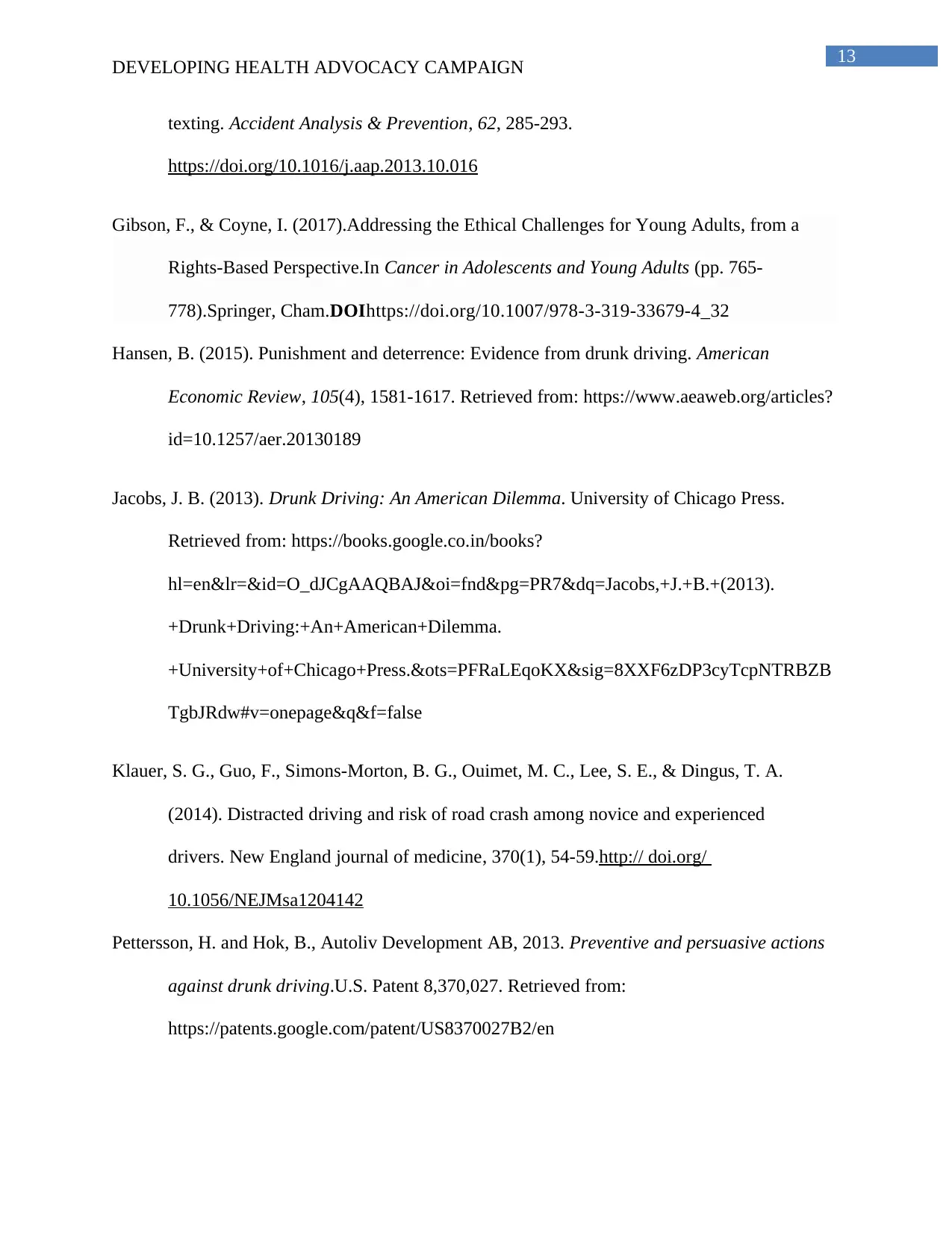
13
DEVELOPING HEALTH ADVOCACY CAMPAIGN
texting. Accident Analysis & Prevention, 62, 285-293.
https://doi.org/10.1016/j.aap.2013.10.016
Gibson, F., & Coyne, I. (2017).Addressing the Ethical Challenges for Young Adults, from a
Rights-Based Perspective.In Cancer in Adolescents and Young Adults (pp. 765-
778).Springer, Cham.DOIhttps://doi.org/10.1007/978-3-319-33679-4_32
Hansen, B. (2015). Punishment and deterrence: Evidence from drunk driving. American
Economic Review, 105(4), 1581-1617. Retrieved from: https://www.aeaweb.org/articles?
id=10.1257/aer.20130189
Jacobs, J. B. (2013). Drunk Driving: An American Dilemma. University of Chicago Press.
Retrieved from: https://books.google.co.in/books?
hl=en&lr=&id=O_dJCgAAQBAJ&oi=fnd&pg=PR7&dq=Jacobs,+J.+B.+(2013).
+Drunk+Driving:+An+American+Dilemma.
+University+of+Chicago+Press.&ots=PFRaLEqoKX&sig=8XXF6zDP3cyTcpNTRBZB
TgbJRdw#v=onepage&q&f=false
Klauer, S. G., Guo, F., Simons-Morton, B. G., Ouimet, M. C., Lee, S. E., & Dingus, T. A.
(2014). Distracted driving and risk of road crash among novice and experienced
drivers. New England journal of medicine, 370(1), 54-59.http:// doi.org/
10.1056/NEJMsa1204142
Pettersson, H. and Hok, B., Autoliv Development AB, 2013. Preventive and persuasive actions
against drunk driving.U.S. Patent 8,370,027. Retrieved from:
https://patents.google.com/patent/US8370027B2/en
DEVELOPING HEALTH ADVOCACY CAMPAIGN
texting. Accident Analysis & Prevention, 62, 285-293.
https://doi.org/10.1016/j.aap.2013.10.016
Gibson, F., & Coyne, I. (2017).Addressing the Ethical Challenges for Young Adults, from a
Rights-Based Perspective.In Cancer in Adolescents and Young Adults (pp. 765-
778).Springer, Cham.DOIhttps://doi.org/10.1007/978-3-319-33679-4_32
Hansen, B. (2015). Punishment and deterrence: Evidence from drunk driving. American
Economic Review, 105(4), 1581-1617. Retrieved from: https://www.aeaweb.org/articles?
id=10.1257/aer.20130189
Jacobs, J. B. (2013). Drunk Driving: An American Dilemma. University of Chicago Press.
Retrieved from: https://books.google.co.in/books?
hl=en&lr=&id=O_dJCgAAQBAJ&oi=fnd&pg=PR7&dq=Jacobs,+J.+B.+(2013).
+Drunk+Driving:+An+American+Dilemma.
+University+of+Chicago+Press.&ots=PFRaLEqoKX&sig=8XXF6zDP3cyTcpNTRBZB
TgbJRdw#v=onepage&q&f=false
Klauer, S. G., Guo, F., Simons-Morton, B. G., Ouimet, M. C., Lee, S. E., & Dingus, T. A.
(2014). Distracted driving and risk of road crash among novice and experienced
drivers. New England journal of medicine, 370(1), 54-59.http:// doi.org/
10.1056/NEJMsa1204142
Pettersson, H. and Hok, B., Autoliv Development AB, 2013. Preventive and persuasive actions
against drunk driving.U.S. Patent 8,370,027. Retrieved from:
https://patents.google.com/patent/US8370027B2/en

14
DEVELOPING HEALTH ADVOCACY CAMPAIGN
Scoccia, D., 2013. The right to autonomy and the justification of hard paternalism. Paternalism:
Theory and Practice, pp.74-92. Retrieved from: http://philos.nmsu.edu/files/2014/07/rt-
to-auto-and-just-of-hp.pdf
DEVELOPING HEALTH ADVOCACY CAMPAIGN
Scoccia, D., 2013. The right to autonomy and the justification of hard paternalism. Paternalism:
Theory and Practice, pp.74-92. Retrieved from: http://philos.nmsu.edu/files/2014/07/rt-
to-auto-and-just-of-hp.pdf
1 out of 15
Your All-in-One AI-Powered Toolkit for Academic Success.
+13062052269
info@desklib.com
Available 24*7 on WhatsApp / Email
![[object Object]](/_next/static/media/star-bottom.7253800d.svg)
Unlock your academic potential
© 2024 | Zucol Services PVT LTD | All rights reserved.